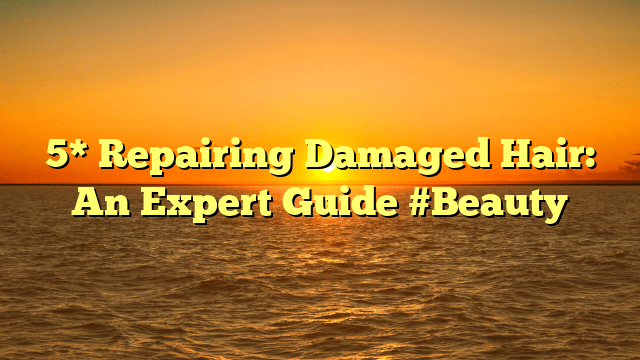Beauty Tips FREE Professional Courses
Repairing Damaged Hair: An Expert Guide

Repairing Damaged Hair: An Expert Guide: Hair damage is a common issue faced by many, but fear not, repairing damaged hair is possible with the right care and products. This comprehensive guide will provide you with expertly curated advice on how to restore your hair’s health and vitality.
Repairing Damaged Hair: An Expert Guide
Understanding Hair Damage
Hair damage manifests in several ways, including split ends, dryness, breakage, and overall dullness. Often, it’s a result of heat styling, chemical treatments, or improper hair care. Recognising the signs of hair damage is the first step towards repairing it.
Beauty Tips FREE Professional Courses
For instance, if you notice an abundance of hair on your brush or bathroom floor, it could be a sign of breakage due to chemical damage. Similarly, if your hair is taking longer than usual to dry, it might be slightly damaged.
“Damaged hair can look different on different hair types, but there are a few things that are quite standard across the board. Visible split ends, or splits in hair mid-shaft, breakage, and dry hair that feels coarse and brittle are all telltale signs of damage.” – Carla Rivas, veteran hairstylist
Repairing Damaged Hair: An Expert Guide
Starting the Journey to Repairing Damaged Hair
The journey to repairing damaged hair involves various steps, from introducing regular haircuts to incorporating new hair care products and even changing your shampooing habits. A few small changes can make a significant difference to the health of your hair.
Incorporating Hair Vitamins
One of the first steps towards repairing damaged hair is the use of hair vitamins. They contain a blend of nutrients that help support hair and scalp health, promoting growth, strength, and protection. For example, Hair La Vie Clinical Formula Hair Vitamins are well-regarded in the industry.

Repairing Damaged Hair: An Expert Guide
Choosing the Right Shampoo and Conditioner
The choice of shampoo and conditioner plays a crucial role in hair health. Look for products enriched with keratin, a moisturiser made of molecules resembling the keratin found in the genetic makeup of hair. This ingredient penetrates the hair, making it softer, more voluminous, and shinier. Additionally, seek out shampoos and conditioners containing vitamins D3, E, and B5, as they support hair and scalp health.
Regular Trims are Essential
Even if you’re growing out your hair, it’s essential to get regular trims to remove dry and split ends. Trimming off these ends prevents splits from travelling up your hair and breaking off more length.
Invest in a Good Hair Mask
Hydrated hair is healthy hair. Therefore, investing in a good moisturising hair mask can help repair damaged strands over time and make your hair look glossy the next day.
Avoid Brushing Wet Hair
Wet hair is more prone to breakage. Therefore, it’s advisable to use a wide-tooth comb or a brush specifically made for wet, fragile hair. Applying a leave-in product before brushing can also help prevent snagging or breakage.
Repairing Damaged Hair: An Expert Guide
Protect Your Hair from the Sun
Just like skin, hair can get damaged by UV rays. Therefore, using a hair sunscreen is a must. It prevents damage and oxidation caused by the sun’s rays and also helps maintain the colour of your hair.

Repairing Damaged Hair: An Expert Guide
Embracing a New Hair Care Routine
Limit Chlorine Exposure
Chlorine, commonly found in swimming pools, can sap the natural oils from your hair, leaving it dry and damaged. Therefore, limit your time soaking your hair in the pool and use products that can protect against chlorine.
The Magic of Hair Oil
Hair oils, such as argan oil and coconut oil, can leave hair soft and manageable. They can be particularly beneficial after a dip in the pool or when your hair feels extra dry.
The Power of Bond-Repairing Hair Treatments
Bond-repairing hair treatments, such as Olaplex and K18, work on a molecular level to rebuild the broken bonds along the hair shaft that give strands their strength and structure. They are excellent for helping repair hair and making it shinier, smoother, and softer.
Don’t Overwash Your Hair
Washing your hair too often can strip it of its natural oils, leading to dryness and damage. Therefore, it’s advisable to use dry shampoo between washes to extend the life of your style and give your hair a break.
Be Gentle with Your Hair
Be gentle with your wet hair as it’s very fragile. Use a wide-tooth comb or wet brush to avoid breakage. Also, choose a boar bristle brush or one that has a mix of plastic and boar’s hair bristles for blow drying as they are less abrasive to hair fibre and scalps.
Repairing Damaged Hair: An Expert Guide
Repairing Dry Hair and Damaged Hair: A Step-by-Step Guide
Having dry and damaged hair can be a frustrating and confidence-damaging issue. However, with the right approach and a bit of care, you can revitalize your locks and restore their natural shine and softness.
In thiis section we’ll walk you through a comprehensive step-by-step guide to help you fix dry and damaged hair, and we’ll address some frequently asked questions along the way.
Step 1: Assess Your Hair’s Condition Start by evaluating the extent of damage to your hair. Identify if it’s mainly dryness, split ends, or brittleness. Understanding your hair’s needs will help you tailor a more effective care routine.
Step 2: Trim Split Ends To kickstart the repair process, visit a professional hair stylist to trim off split ends. Regular trims are essential for maintaining healthy hair.
Step 3: Gentle Cleansing Use a sulfate-free shampoo to avoid stripping natural oils from your hair. Wash your hair with lukewarm water, as hot water can further dehydrate it.
Step 4: Deep Conditioning Incorporate a deep conditioning treatment into your hair care routine at least once a week. Look for products rich in essential oils, proteins, and moisturizing agents to nourish and repair your strands.
Step 5: Moisturize and Seal After washing, apply a leave-in conditioner or hair serum to lock in moisture and prevent frizz. This step is crucial for maintaining hydration throughout the day.
Step 6: Heat Styling Precautions Reduce your use of heat styling tools like straighteners and curling irons. When you do use them, apply a heat protectant spray to shield your hair from damage.
Step 7: Avoid Overwashing Frequent washing can strip your hair of natural oils, exacerbating dryness. Aim to wash your hair every 2-3 days or as needed based on your hair type.
Step 8: Use a Wide-Tooth Comb Minimize breakage by detangling your hair gently with a wide-tooth comb. Start from the ends and work your way up to avoid tugging on knots.
Step 9: Hydrating Hair Masks Treat your hair to a hydrating hair mask once a week. Look for ingredients like avocado, coconut oil, or shea butter to provide deep nourishment.
Step 10: Protect Your Hair at Night Sleep on a satin or silk pillowcase to reduce friction and prevent damage to your hair while you sleep.
Repairing Damaged Hair: An Expert Guide
FAQ for Repairing Dry Hair
Q1: Can I fix my dry and damaged hair overnight?
A: Repairing damaged hair takes time and consistent care. While some immediate improvements are possible with deep conditioning treatments, expect gradual results over several weeks or months.
Q2: How often should I trim my hair to prevent split ends?
A: Regular trims every 6-8 weeks can help prevent split ends from worsening and promote healthier hair growth.
Q3: Can I use regular conditioner as a leave-in conditioner?
A: While it’s possible, using a dedicated leave-in conditioner is more effective. They are formulated to be lightweight and provide ongoing hydration without weighing down your hair.
Q4: Are there any natural remedies for dry hair?
A: Yes, some natural remedies include coconut oil, argan oil, and aloe vera. These can be used as hair masks or added to your conditioner for extra nourishment.
Q5: Can I still dye or bleach my damaged hair?
A: It’s best to avoid chemical treatments on already damaged hair. Wait until your hair is healthier and consider consulting a professional stylist to minimize potential damage.
Repairing dry and damaged hair is a process that requires patience and consistent care. By following this step-by-step guide and adopting a gentle hair care routine, you can gradually restore your hair’s health, shine, and vitality.
Remember to stay consistent and be kind to your hair throughout the journey to achieve the best results.
Repairing Damaged Hair: An Expert Guide
Final Thoughts
Repairing damaged hair is a journey that requires patience and consistent care. With the right products and care routine, you can restore your hair’s health and prevent future damage. Embrace the journey and remember, every small step you take towards repairing your hair is a step towards healthier, shinier hair.
“Your hair is the crown you never take off.” – Beauty Tips
Remember, you’re not alone in this journey. We’re here to guide you every step of the way, like a trustworthy mentor, providing you with expert advice and personalised solutions for your hair care needs.
Note: Always consult with a professional stylist or hair care expert before making significant changes to your hair care routine or using new products.
Beauty Tips FREE Professional Courses
